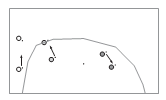Hockey drills for technique condition
- 2 equal teams, or in case of odd numbers with a joker,
- try to keep the players on the team for as long as possible.
- This can be done through short replay, the duel and then replay.
- give each other the right arm and bend your knees in a sitting position.
- idem left arm
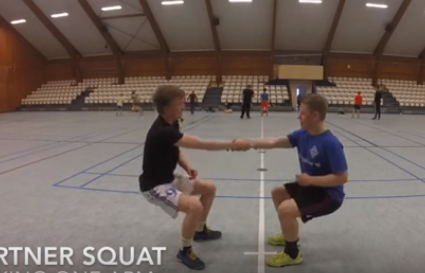
- Two pairs shake hands in a crossed position (see photo) and kneel down in the sitting position.
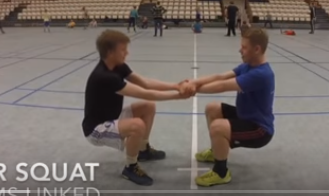
- 2 opposite each other, bend their knees in the sitting position and come up and kick forward with the left and right leg alternately.
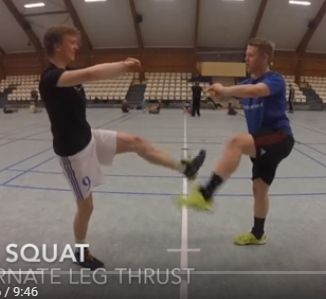
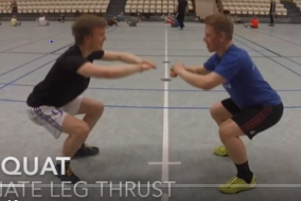
Two pairs sit down and stand up at the same time, with their backs against each other.
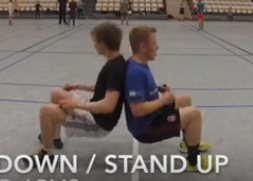
- 2 groups of players stand behind each other,
- back player lifts leg of player in front of him.
- the player in front of him goes through the knees with the other leg.
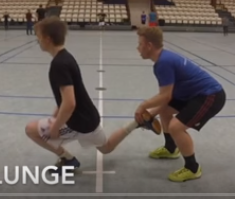
- There are 2 passers on the PC points on the back line to the right and left of the goal.
- The player starts behind the 25 yard line, receives the ball from the left, gets the ball to the semi-circle and then has to score.
- This player then sprints past the penalty mark, then sprints back behind the 25 yard line, and then has to run back towards the goal to receive the pass from the other attacker (right) and do the same (scoring, sprint past the strokepunt/puntball point and back to the 25 yard line)
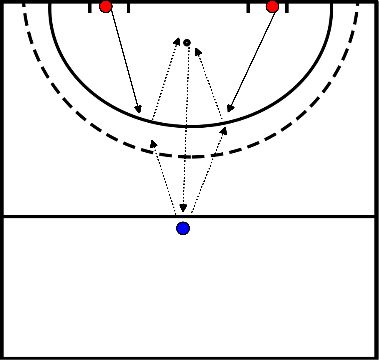
- Keeper on target
- Place 2 gates of pilons on the 23-metre line (the gates are on the left and right side of the goalposts)
- Player red starts on the head circle and accelerates with ball through the gates.
- Immediately after passing the gates, red passes to blue.
- Red sprints around a pilon to put pressure and/or take the ball away from blue.
- After receiving the ball, blue accelerates with ball and runs through the gates.
- If blue passes through the gates, red is not allowed to take the ball and has to go back to the pilon.
- Blue accelerates into the head circle and shoots at the goal.
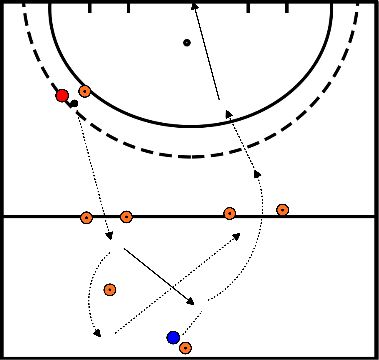
- Make a triangle with pilons (2 meters between each pilon).
- Player red starts with ball at the pilon 5 meters away from the triangle.
- Player red passes to player blue while he dynamically moves towards and around the triangle.
- Player blue pivots the ball and plays the ball to player white.
- Player white plays the ball back to the starting point (red).
- During the exercise, each player runs behind his/her ball.
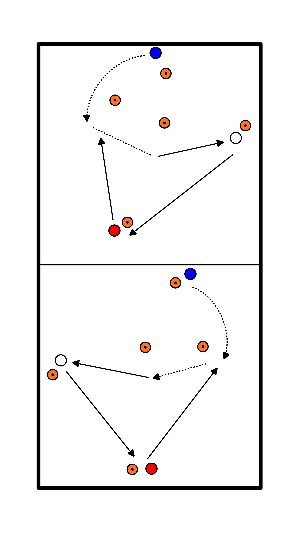
- Everybody's got a ball, you're facing each other on the 23-metre line.
- Left and right is a line of pilons.
- The ball is light under your legs, at some point the trainer tells you how to stand (on your left leg, or touch your ankles) then the trainer calls left or right and you have to run to that side as quickly as possible and the ball must lie still on the line with pilons,
- If the ball is still on the line, run back to the 23-metre line as quickly as possible.
- Whoever is first wins.
- The pilons are about 3 or 4 metres from the 23 metre line, on both sides.
Place 15 to 20 pylons over a distance of about 40 metres from the rear line towards the middle line, in a straight line. The spacing between them at the basic form is 2 meters.
Make 2 rows that are positioned behind the back line. The players do their exercise on both sides of the pylons at the same time towards the end of the series of pylons. There they turn and dribble with a wide curve back to the beginning. When the first two are at the fourth pylon, the next two can start.
Put players with an equal physical capacity next to each other. You can do a positional approach (defender versus defender, attacker versus attacker).
Exercise
1. On the signal the front 2 players start.
2. Sprint each time 2 pylons forward and then 1 pylon backward.
3. Keep your face forward, so don't turn during the exercise.
4. The intensity is 90% of the maximum capacity. Especially the forward runs (starting away) must be explosive and with short steps.
5. At the end of the series of pylons you turn with a wide bend and dribble easily back to the starting point.
6. Repeat this exercise once.
Variations
1. Identical to the basic form, but now with the pylons in a different pattern: between the first 2 pylons is 1 meter, between the next 2 meters, then 3 meters, 4 meters and finally 5 meters. After this you go down again (respectively 4, 3, 2 and 1 meter space between the pylons). In total you will have 18 pylons.
2. Identical to the basic form, but now with a different pattern: between the first 3 pylons 1 meter, the next 2 pylons 5 meter, then again 3 pylons with 1 meter, 2 pylons with 5 meter. After this, place the same pattern again (4 times the same pattern in 1 line, with a total of 18 pylons).
3. Identical to variation 3, but now you don't place the pylons in a straight line, but in curves.
4. You make a straight line of pylons and arrange them as you see fit. Make sure there is a lot of variation.
5. Identical to variation 4, but now with faint curves.
Intensity of the exercise
The intensity is 90% of the maximum effort. Panting, should be motivated execution with highly explosive character in the runs with a maintained body control and athletic posture, EMI 7/8.
- Make groups of 2.
- No. 1 must try to hit the ball of
- no. 2, staying in a designated area. How often does No. 1 succeed? After some time, switch around and No. 2 may try to hit the ball of No.1.
